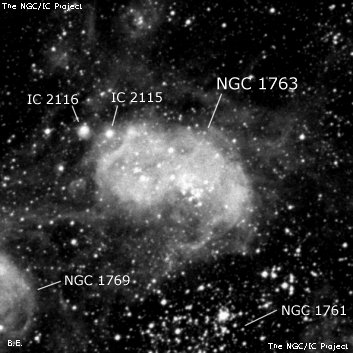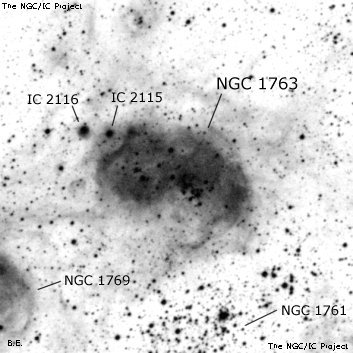NGC/IC Project Restoration Effort
(This is a very very beta version)
NGC1763


Basic Information
Location and Magnitude
Right Ascension: 4:56:45.0
Declination: -66:25:6
Constellation: DOR
Visual Magnitude:
Historic Information
Discoverer: Dunlop
Year of discovery: 1826
Discovery aperture: 9.0
Observational
Summary description: vB, vL, vimE
Sub-type: EN
Corwin's Notes
=====
NGC 1763 is a bi-lobed complex of HII regions and star clusters in the LMC.
JH's descriptions and positions from five different sweeps are appropriate,
though he was not happy with one of his RA's. His position is toward the
middle of the western "lobe" of the nebula. This is where the brightest stars
are located, including the "chief of which in the anterior part of the neb
[was] taken." In the one sweep when he estimated the size of the nebula,
though, he made it four arcmin long and 2.5 arcmin across, almost exactly what
we seen on the short exposure DSS1 V-band plate.
The position I've adopted is more toward the intersection of the "lobes" and
is more representative of the entire nebula.
One last note on this: this is not identical to either IC 2115 or 2116, in
spite of what ESO claims. It is possible, though, that the IC numbers refer
to parts of NGC 1763. See I2115 for more on this.
Note, too, that I had most of this note incorrectly loaded under the number
"1736" for a while. My apologies!
Steve's Notes
=====
NGC 1763
30" (11/4/10 - Coonabarabran, 264x): The Bean Nebula complex (LHA 120-N11) is the second largest stellar nursery in the LMC after the Tarantula Nebula. The showpiece is NGC 1763, which sits near the center of a stunning field of emission nebulae and clusters including NGC 1760 7' S, NGC 1761 3' S, NGC 1769 6.5' SE, NGC 1773 8' ENE and NGC 1776 11' E. NGC 1763 is a very bright, very large irregular nebula, shaped like a kidney-bean or a fetus. The main body extends 5'x3', elongated SW-NE with a bulbous portion on the northeast side and an indentation (weaker nebulosity) on the south side. Overall the surface brightness is very high, though uneven, and much fainter haze and filaments flow out from the Bean in most directions. Within the main body, the nebula is brightest in a loop on the southwest side and secondly in a section on the northeast side.
Involved with NGC 1763 is a large cluster catalogued as OB-association LH 10 (the youngest cluster in the LMC-N11 complex), with roughly two dozen resolved stars. This cluster includes a number of 12-13 mag stars (several of which are massive O3-type stars), many in an elongated 1' group on the southwestern side. At the northeast edge is mag 11.3 HD 268726 (sometimes identified as IC 2115) and 45" further east is IC 2116, a high surface brightness knot of ~15" diameter. Very faint haze at the NE side of NGC 1763 bulges towards IC 2116. The surrounding field is rich in stars between the individual objects with some locally brighter patches of nebulosity.
13.1" (2/17/04 - Costa Rica): this emission nebula and cluster is set in fascinating field of several clusters and HII regions including NGC 1761, 1769, and 1773. The nebula is fairly bright, large, very elongated WSW-ENE, 4'x2'. A few stars are superimposed on the nebulosity. The roughly oval outline is irregular and the HII region appears brighter on the WSW side near a rich group of stars at the WSW tip. A couple of mag 11 stars are close off the NE end. IC 2115 and IC 2116 comprise the western and eastern portion of this object. After viewing this group of objects, the LMC which was well past the meridian disappeared behind some low clouds.



